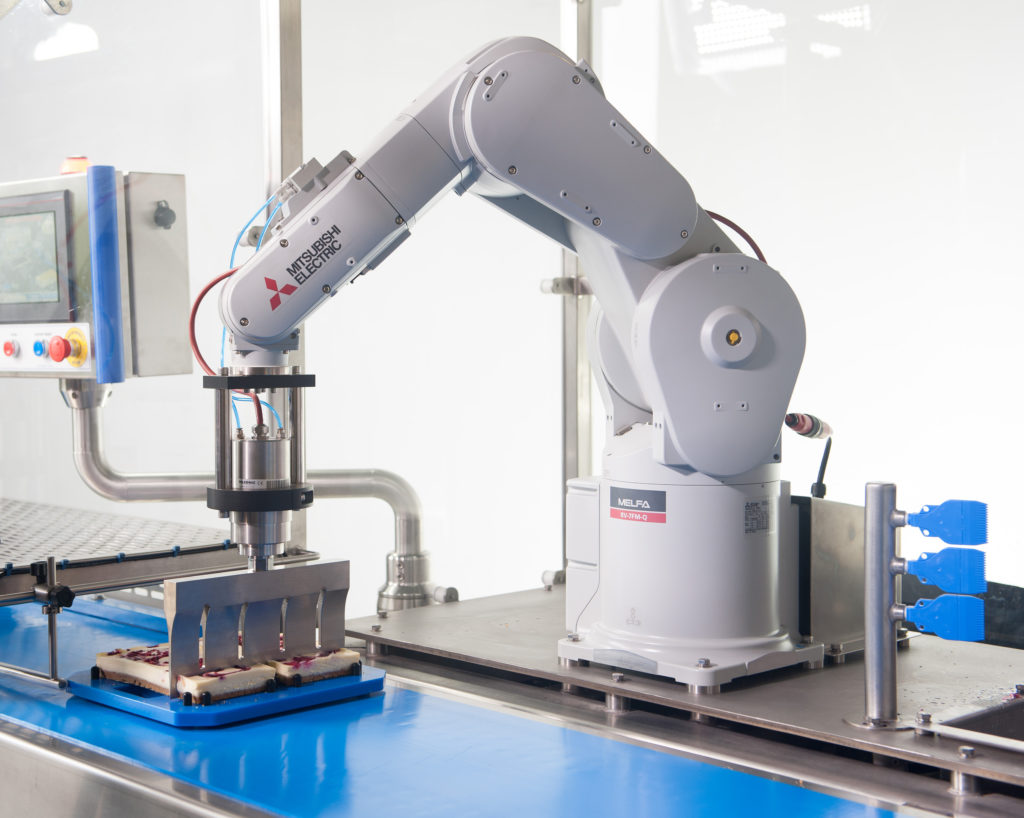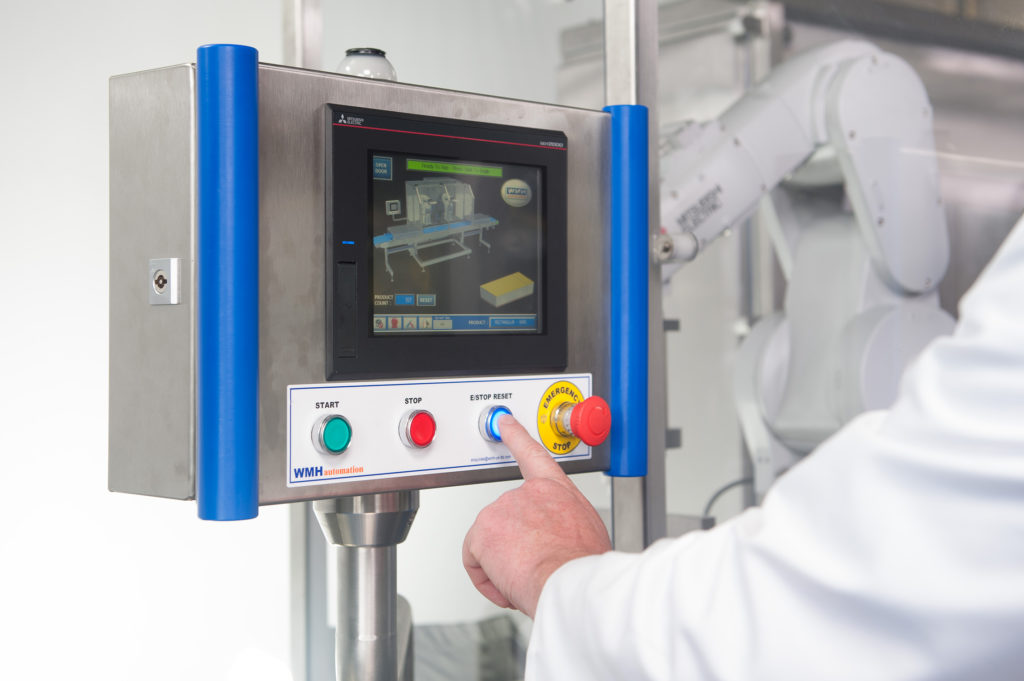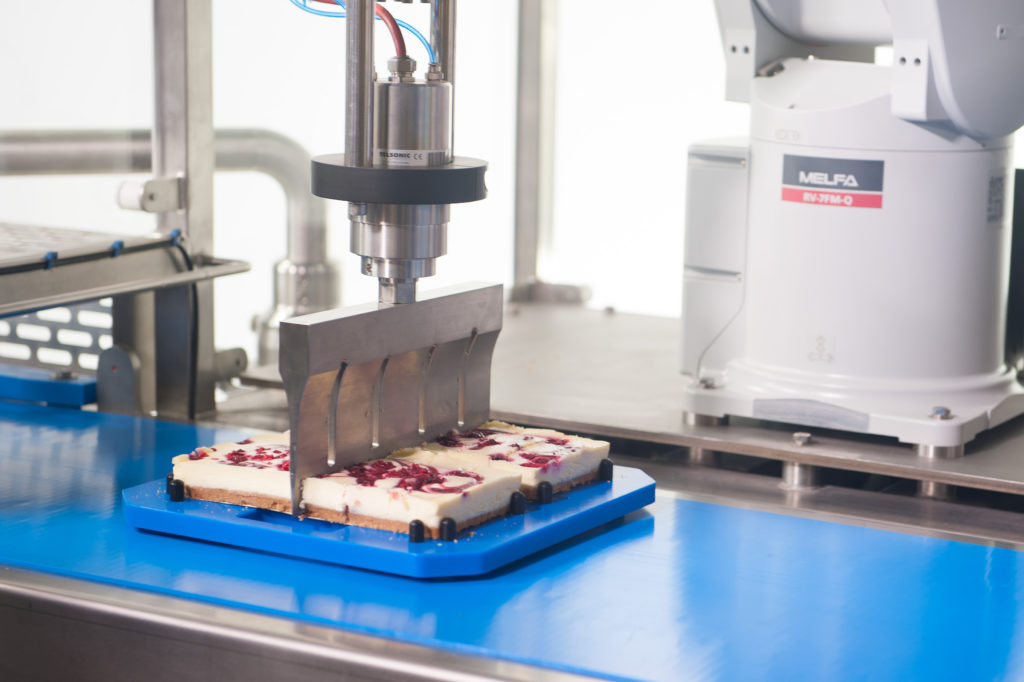Mitsubishi Electric has assisted Western Mechanical Handling (WMH) to develop a fully automated inline cell for cutting and slicing food of any size and shape on the fly.
The solution is based on Mitsubishi Electric’s MELSEC Q series high-performance PLC, plus system-matched components including HMI, variable speed drives and two MELFA articulated arm robots.
The resulting machine maximises performance, flexibility and productivity for customers in the food sector.
Competition in the food industry is fierce and the fast pace of business and development means that any advantage can have a considerable impact on margins for food producers. This inline cutting unit offers significant advantages, as it can substantially reduce slicing time and reduce wastage due to its high accuracy and consistency.

“Thanks to our 40 years of expertise in this sector, we noticed a growing need in the market for better industrial food cutting solutions. Until now, industrial food cutting has often been a manual task. Even when automated, most solutions do not allow continuous processing because the robots used require the food to be stationary. As a result, cutting operations often slow down the entire production line, increasing lead times,” explains Helen Northcott, Technical Sales & Marketing Manager at WMH.
The company’s new inline cutting unit marks a turning point, as it is characterised by a conveyor belt that connects the production line to the slicing stage and any subsequent process. As food trays move forwards, their content is sliced without stopping the conveyor belt.
A winning team of experts
WMH’s goal consisted of developing an automated cutting system that would deliver unprecedented high-quality and high-speed cutting without interruptions.

To do so, the company chose to integrate state-of-the-art technologies from leading manufacturers Mitsubishi Electric and Telsonic.
A big contributing factor in the machine’s versatility are two robotic arms from Mitsubishi Electric, which can attune to the line speed and do all the necessary cuts on the move.
The robots can perform quality slicing by means of state-of-the-art ultrasonic blades from Telsonic, a leading manufacturer of industrial ultrasonic systems.
Steve Kirby, Sales Manager at Mitsubishi Electric, comments: “WMH is a longstanding customer of Mitsubishi Electric. The company is well acquainted with the capabilities of our automation equipment and incorporates it in a range of cutting-edge solutions – no pun intended!”
From the early planning stages, the three companies discussed how to build an efficient, flexible solution that would also address the strict hygiene requirements of the food processing industry.

Mitsubishi Electric’s RV-F series of six-axis robots was ideal to address these challenges, as it offers class-leading speed, precision as well as IP65 ingress protection for food grade wash-down working environments.
The automated operation of the robotic arms is regulated by a compact MELSEC-Q series high-performance PLC designed for small-scale applications. The PLC then acts as an intermediary between the robots and a GOT2000 HMI, which enables human operators to easily set what type of cutting is required and monitor the process.
The machine can cut substances with different consistencies packed in various food tray shapes and sizes without requiring any hardware modifications.
In fact, all these cases are characterised by distinctive cutting needs. For example, chilled goods would require a slower cutting speed compared to softer foods.
Similarly, chopping orientations and angles for round products, such as pizza, differ from rectangular tray bake products like flapjacks.
Going ultrasonic
Ultrasonic blades can cut different materials quickly, with high accuracy and by applying very low pressures.
When compared to conventional blades, the number of crumbs and waste produced is considerably lower, especially when cutting near the edges of the material.
Even more, when faced with variable ingredients and toppings, such as cherries in a cake, these are sliced without squeezing them or damaging the whole product, ensuring an aesthetically pleasing result.
Telsonic adds: “The ultrasonic blades used in this application are 760 mm long, which makes them the largest available on the market. This not only results in faster cycle times, but also higher quality. When slicing large trays, fewer cuts on the same axis are required, minimising the risk of misalignment. The ability to self-clean and maintain a sharp blade, further streamline the process.”
Cutting-edge precision
Ensuring the optimal assembly of the articulated robots and the ultrasonic blades was key to ensure advanced performance. Telsonic commented: “The optimisation process was a joint effort. It was a pleasure to work with Mitsubishi Electric specialists. They quickly understood our ultrasonic process and how to integrate it onto their robots.”
Particular attention during the design phase was given to establishing a dependable position tracking system, which is key to ensuring the robots cut the food correctly, without affecting the food trays or conveyor belt.
Steve Kirby explains: “Ultrasonic blades are extremely powerful, so we had to make sure they would cut through the product completely and stop before reaching the tray. Our solution can repeatedly position itself correctly with an accuracy of 20 μm. Yet, we also had to minimise any upward or downward movement of the conveyor belt.” To do so, the conveyor belt uses Mitsubishi Electric’s variable speed drives to regulate its horizontal motion whilst eliminating any height variation.
Benefits immediately noticed by food manufacturers
Helen Northcott comments: “The in-depth discussion that Mitsubishi Electric’s specialists conducted with our team as well as their responsiveness proved extremely helpful in setting up a highly accurate cutting system that is now attracting much interest in the sector.”
The twin robot inline ultrasonic cutting unit has already been adopted by leading food producers, such as Bakkavor. The business has decided to install the machine at its dessert factory in Highbridge, where it will contribute to automating the new production line for chilled confections.
Daron Sirmon, Project & Compliance Engineering Manager at Bakkavor Desserts – Highbridge, confirms: “We decided to go with WMH and its latest solution for Bakkavor’s new cheesecake line after visiting the premise and seeing one of the units in action. The decision was based on the easy user interface and the speed of operation. We also felt the professionalism and technical know-how were major contributors in our decision.
 Engineer News Network The ultimate online news and information resource for today’s engineer
Engineer News Network The ultimate online news and information resource for today’s engineer





